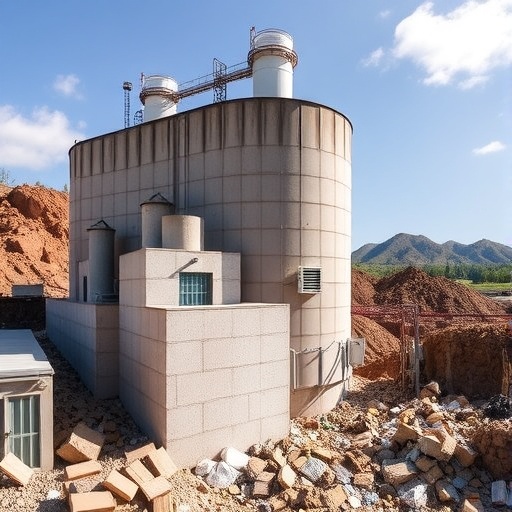In an era of heightened environmental consciousness, researchers are continually exploring innovative solutions to combat waste and promote sustainability. Among these efforts, the groundbreaking work by Gurdjos and Bourgeois stands out, bringing forth a novel approach to waste management through the upcycling of high-performance concrete. Their study, titled “A High-Performance Concrete Waste Upcycling Solution Using Microwaves and Carbonation,” sets a new benchmark in the field of recycling concrete, offering a promising pathway for reducing the ecological footprint of construction activities.
Concrete, one of the most widely used construction materials worldwide, poses a significant environmental challenge. The production of cement, a primary ingredient in concrete, contributes substantially to carbon dioxide emissions, responsible for approximately 8% of global CO2 emissions. As urbanization and infrastructure development continue to surge, the amount of concrete waste generated is expected to increase, making it essential to find effective recycling methods. Traditional recycling techniques often fall short, necessitating the exploration of innovative methods capable of yielding higher quality materials for reuse.
In their ambitious study, Gurdjos and Bourgeois introduce a method that harnesses the power of microwave heating combined with carbonation to transform concrete waste into a high-performance material. At the core of their approach is the understanding that conventional recycling methods often lead to a reduction in the mechanical properties of the recycled concrete. By employing microwave energy, the researchers can enhance the treatment of concrete waste, providing a more uniform and effective heating process. This technique significantly reduces processing times, which is a critical factor in large-scale operations.
The carbonation process, when paired with microwave treatment, further maximizes the potential of recycled concrete. Traditionally, carbon dioxide is considered an environmental hazard, but in this innovative context, it serves a dual purpose. As concrete waste is exposed to carbon dioxide during the upcycling process, the researchers facilitate a chemical reaction that incorporates CO2 into the concrete structure. This not only helps sequester greenhouse gases but also enhances the durability and strength of the recycled material, thus creating a sustainable cycle of resource usage.
The experiments conducted by Gurdjos and Bourgeois demonstrate that their microwave-assisted carbonation method can successfully convert concrete waste into a high-performance material suitable for a variety of applications in construction. The resulting product exhibits comparable if not improved mechanical properties relative to traditional concrete, ensuring that it can be used effectively in new structures. Furthermore, the reduction in energy consumption associated with this microwave treatment presents an additional environmental benefit, making the entire process more sustainable.
Notably, the implications of this research extend beyond the confines of laboratories and academic journals. By innovating a method that enhances the value of waste concrete, Gurdjos and Bourgeois are addressing a significant challenge faced by the construction industry—the need for eco-friendly practices that comply with increasingly stringent environmental regulations. Their findings are poised to influence policy makers, environmentalists, and construction professionals, encouraging the adoption of sustainable practices.
Moreover, the method proposed by the researchers has the potential to inspire future innovations in waste management across various industries. The principles behind microwave-assisted carbonation could be applied in other sectors looking to reduce waste and improve material efficiency. This cross-industry applicability underscores the importance of interdisciplinary collaboration in developing technologies that foster sustainability.
In conclusion, the research conducted by Gurdjos and Bourgeois marks a pivotal advancement in the upcycling and recycling of concrete waste. Their innovative method not only proposes a solution to a significant environmental issue but also promotes the idea of a circular economy in the construction sector. As the global community continues to grapple with the challenges of climate change and resource scarcity, studies like this provide a glimmer of hope and a roadmap toward a more sustainable future.
With the successful application of microwave and carbonation technologies to concrete waste, there is an urgent call for further exploration into the scalability of these methods. Industries and governments must consider investing in research and development that enhances the practicality of high-performance recycled materials. As the construction industry increasingly looks to reduce its carbon footprint, the work of Gurdjos and Bourgeois provides inspiration for future endeavors aimed at creating resilient and sustainable urban environments.
As societies transition toward a greener future, collaboration between academia, industry, and policy makers will be essential. By coming together to explore and implement innovative recycling solutions, stakeholders can foster a shift in practices that promotes sustainability and environmental responsibility. Gurdjos and Bourgeois’s findings contribute significantly to this conversation, demonstrating that it is possible to turn a challenge into an opportunity through creative and scientific approaches.
The groundwork laid by this study points to a future where concrete waste is no longer seen as a burden, but as a valuable resource in construction. With ongoing research and innovation, this vision can become a reality, reshaping the way we approach construction and waste management. Ultimately, as more researchers build on the methodologies introduced in this study, the potential for material upcycling extends not just within the realm of concrete, but also across various materials, leading to a transformative shift in the waste management landscape worldwide.
The art of recycling and upcycling concrete waste through advanced technology represents a paradigm shift, encouraging a re-evaluation of current practices in the construction industry. It illustrates a path toward a more sustainable future enriched with research-backed methodologies that could redefine how we consume and repurpose resources. As the world grapples with the intricate relationship between development and environmental stewardship, initiatives like these will play a vital role in harmonizing progress with sustainability.
Subject of Research: Upcycling of concrete waste using microwaves and carbonation.
Article Title: A High-Performance Concrete Waste Upcycling Solution Using Microwaves and Carbonation.
Article References:
Gurdjos, C., Bourgeois, F. A High-Performance Concrete Waste Upcycling Solution Using Microwaves and Carbonation.
Waste Biomass Valor (2025). https://doi.org/10.1007/s12649-025-03315-y
Image Credits: AI Generated
DOI: 10.1007/s12649-025-03315-y
Keywords: Concrete waste, upcycling, microwave treatment, carbonation, sustainability, circular economy.




